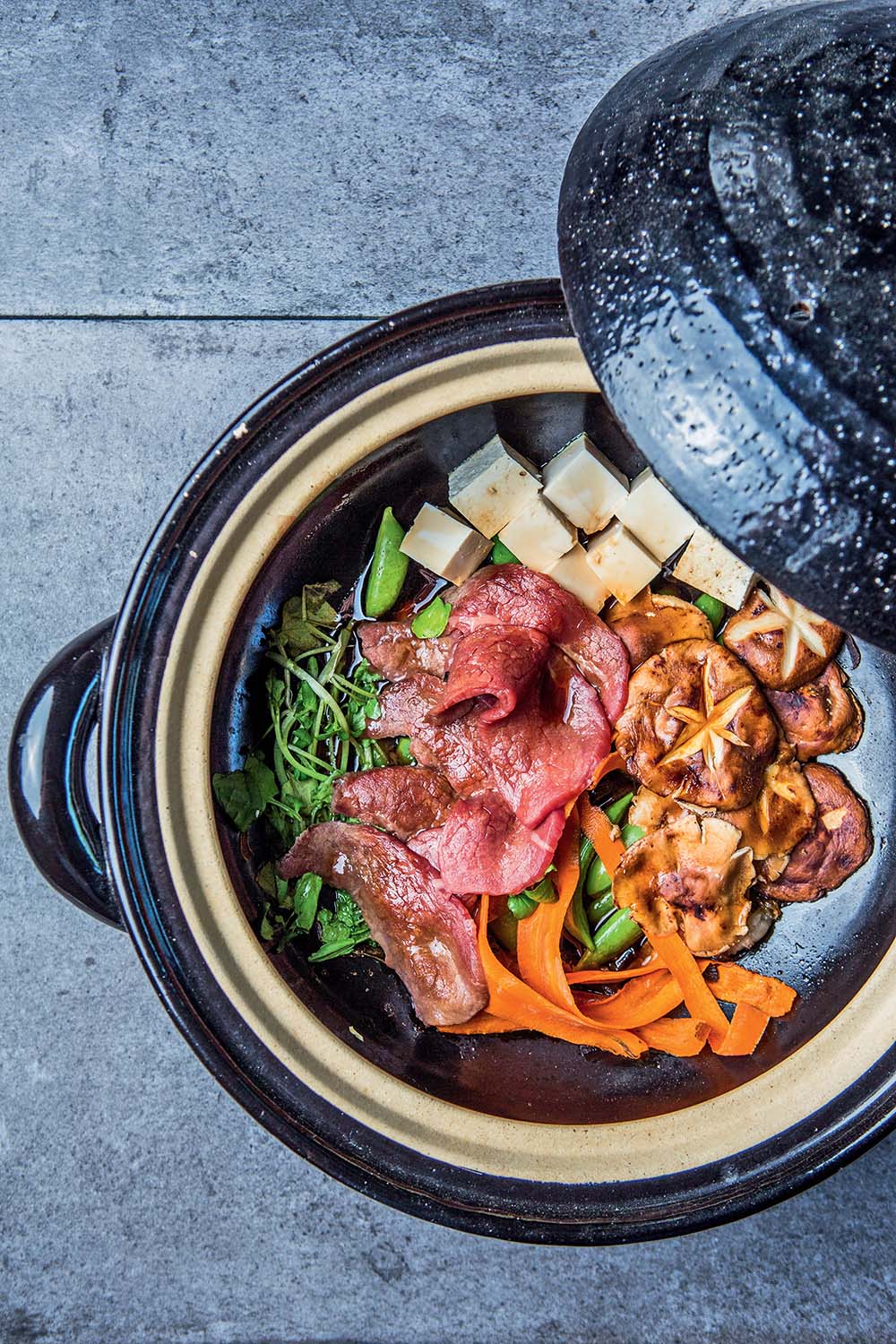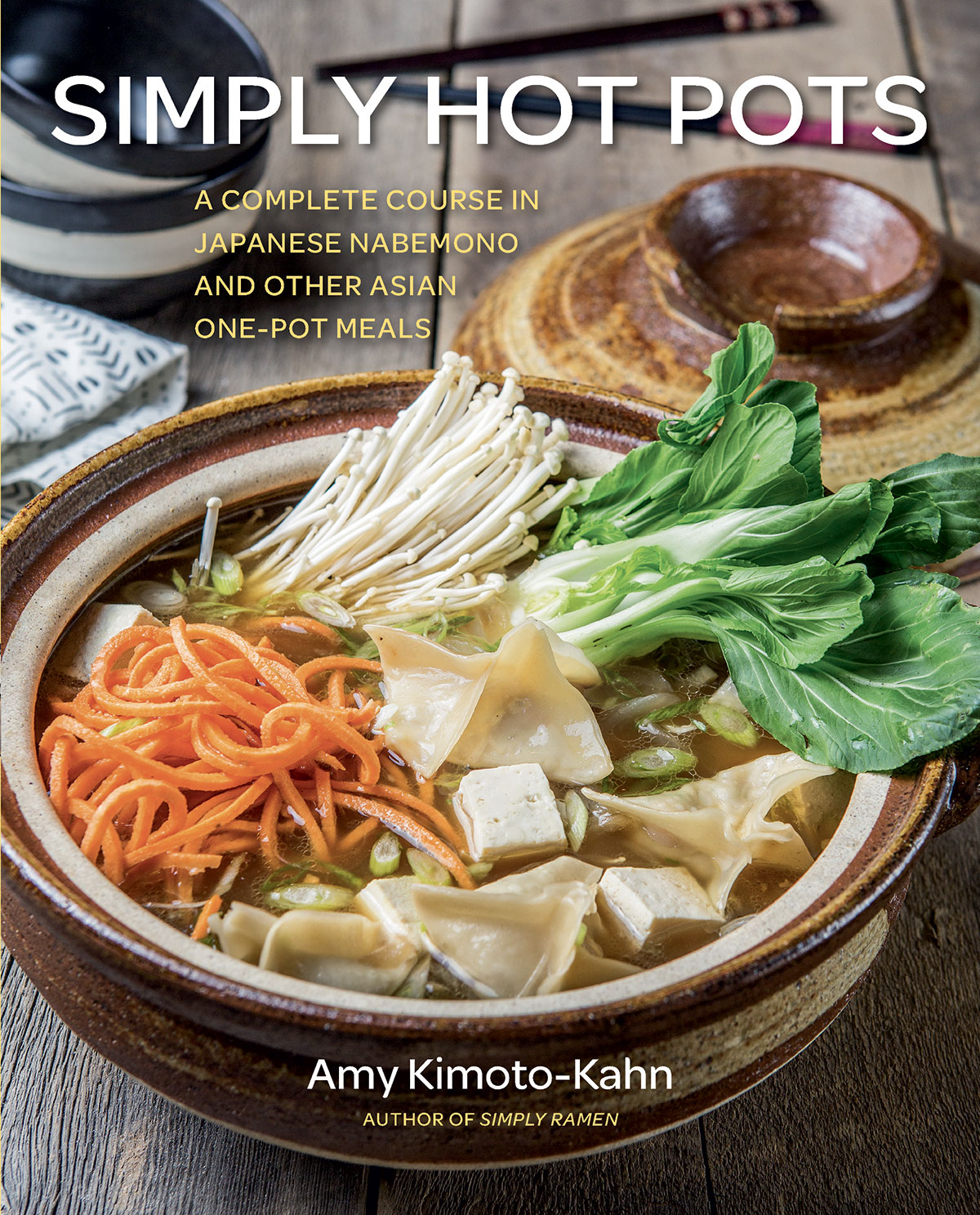Recipe for Kobe Beef Sukiyaki by Amy Kimoto-Kahn
The chef proposes a recipe to make a more refined version of a Japanese hotpot using prestigious wagyu beef.

Race Point Publishing
There is no shortage of superlatives used by meat lovers to describe Kobe wagyu beef, the quintessential type of this meat. In her book Simply Hot Pots, Amy Kimoto-Kahn shares a recipe for sukiyaki garnished with wagyu, from the Japanese Black breed, which are fed exclusively on grain for months; this is what lends the meat its distinctive marbled appearance.
‘It is an incredibly simple meal you can make with any protein and vegetables you have on hand’, explains Amy Kimoto-Kahn, who has adapted her recipe for those unable to get hold of the famous Kobe beef.
The particular characteristic of sukiyaki compared to the traditional shabu-shabu hotpot is the fact that it is accompanied by a beaten egg for dipping the cooked beef and vegetables before eating them. ‘This gives the food a silky, luxurious texture that’s surprisingly addictive’, the chef reveals.
Ingredients
680 g Kobe beef (or rib-eye or Angus beef), very thinly sliced
140 g shiitake mushrooms, cleaned, trimmed, and sliced
1 bunch watercress, stemmed
1 large carrot, shaved into thin ribbons with a vegetable peeler
113 g sugar snap peas, trimmed
1 block (395 g) extra firm silken tofu, drained and cut into 2.5-cm cubes
509 g prepared udon noodles, drained
2 pieces (2.5 cm each) beef suet (or 2 tablespoons/30 ml bacon fat or vegetable oil)
1/2 medium sweet onion, thinly sliced, divided
120 ml Basic Sukiyaki Sauce, divided, plus more as needed
Toasted white sesame seeds, for garnishing
4 to 6 large eggs, lightly beaten (preferably pasteurised, as they will be eaten raw; optional)
Method
Arrange the beef, mushrooms, watercress, carrot, peas, tofu, and noodles on platters. Place the platters on the table around the hot pot.
In a 3.8-l hot pot or large saucepan over medium-high heat (about 425F, or 220C, in an electric hot pot), melt one piece of suet until it is rendered. You may have a bit of cartilage left over, but you can keep it in the pot. Add half the onion. Cook for about five minutes, stirring occasionally, until translucent.
Add half the vegetables and tofu to the pot. Cook for about two minutes, stirring, until the vegetables begin to soften.
Arrange half the sliced beef on top of the vegetables. Drizzle with 60 ml of sukiyaki sauce. Reduce the heat to medium and cook for about one minute, until the beef begins to turn brown. Flip the beef and cook for one minute more.
Fold the beef into the vegetables and tofu until evenly coated with the sauce. Cook until the beef is tender and almost cooked through, about one minute. If food starts to stick to the bottom of the hot pot, reduce the heat and add a little water to cool it down.
Transfer the beef sukiyaki to plates and garnish with sesame seeds. Serve with individual bowls of lightly beaten egg for dipping.
Repeat the process with the remaining suet, onion, vegetables, tofu, beef, and 60 ml sukiyaki sauce.
When the vegetables, tofu, and beef have been eaten and you are left with just the sauce in the bottom of the hot pot, add the udon noodles.
Cook for two to three minutes, stirring, until heated through and coated with sauce, adding more sauce, if needed. Serve the noodles as the shime (end-of-meal course).
Simply Hot Pots (2019), a recipe book by Amy Kimoto-Kahn, is published by Race Point Publishing, in English only.
Author of the blog easypeasyjapanesey, private chef Amy Kimoto-Kahn lives in Colorado with her family. In her book Simply Hot Pots, she shares 75 recipes for comforting Japanese hotpots. Alongside these, she also offers fifteen recipes for broth, a central element in winter dishes. These hotpots can be served in the classic style, with meat, or can be made entirely vegetarian.
A graduate of the Miyajima Ramen School in Osaka, Amy Kimoto-Kahn has also written Simply Ramen, which outlines various versions of this popular Japanese dish.

Race Point Publishing
TRENDING
-
The Tattoos that Marked the Criminals of the Edo Period
Traditional tattoos were strong signifiers; murderers had head tattoos, while theft might result in an arm tattoo.

-
Chiharu Shiota, Red Threads of the Soul
Last year, more than 660,000 people visited the retrospective 'Chiharu Shiota: The Soul Trembles' exhibit at the Mori Art Museum.

-
‘Before Doubting Others, Doubt Yourself. Who Can Truly Say a Dish Isn’t What It Used to Be?’
In ‘A Non-Conformist’s Guide to Surviving Society’, author Satoshi Ogawa shares his strategies for navigating everyday life.

-
The Story of Sada Yacco, the Geisha who Bewitched Europe
Described by Dazed magazine as the first beauty influencer, she has been restored to her former glory since 2019.

-
Ito Jakuchu's Naturalist Paintings
From 15 September until 14 October 2018, the Petit Palais showcased the artist's iconic ‘Images of the Colourful Realm of Living Beings’.





